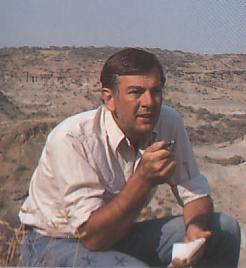Copyright © Jim Foley || Email me

 Donald Johanson was born in Chicago in 1943, the son of Swedish immigrants.
His father died when he was two, and his mother moved to Hartford,
Connecticut, where he developed an interest in anthropology from a
neighbour who taught the subject. Although he initially studied chemistry
at university, he eventually switched majors to anthropology, and worked
during summers on archeological digs. He transferred to Chicago to study
under F. Clark Howell for his graduate studies, doing a comprehensive study
on chimpanzee dentition for his doctoral thesis. In 1970 and 1971 he
visited Africa to do field work at Omo in Ethiopia. In 1972, he and some
colleagues went on a short exploratory expedition evaluate the Afar
Triangle region of Ethiopia. They were impressed by its promise, and
planned a full scale expedition the following year. Back in the USA,
Johanson completed his Ph.D. and started a teaching position at Case
Western Reserve University.
Donald Johanson was born in Chicago in 1943, the son of Swedish immigrants.
His father died when he was two, and his mother moved to Hartford,
Connecticut, where he developed an interest in anthropology from a
neighbour who taught the subject. Although he initially studied chemistry
at university, he eventually switched majors to anthropology, and worked
during summers on archeological digs. He transferred to Chicago to study
under F. Clark Howell for his graduate studies, doing a comprehensive study
on chimpanzee dentition for his doctoral thesis. In 1970 and 1971 he
visited Africa to do field work at Omo in Ethiopia. In 1972, he and some
colleagues went on a short exploratory expedition evaluate the Afar
Triangle region of Ethiopia. They were impressed by its promise, and
planned a full scale expedition the following year. Back in the USA,
Johanson completed his Ph.D. and started a teaching position at Case
Western Reserve University.
In 1973 he discovered AL 129-1, a small but humanlike knee, and the first knee known from the hominid fossil record. The following year, Johanson and Tom Gray discovered an even more spectacular find, AL 288-1, a partial skeleton of a female australopithecine better known by its nickname of Lucy. In 1975 there was yet another major find when his team found a collection of fossils at a single site which was nicknamed the First Family. In 1976, more hominid fossils were discovered, along with stone tools which, at 2.5 million years, were the oldest in the world. After 1976, political conditions in Ethiopia prevented further expeditions for nearly 15 years.
Johanson, who in 1974 had become a curator at the Cleveland Museum of Natural History, now tackled the task of analyzing the fossils with the aid of Tim White, a young but highly regarded scientist who had just finished his Ph.D. Johanson had originally been of the opinion that the Hadar fossils were a mixture of Homo and Australopithecus specimens, but White eventually convinced him that all of them belonged to just one species. In 1978 they named that species Australopithecus afarensis.
In 1981, Johanson founded the Institute of Human Origins, a non-profit research institution devoted to the study of prehistory. In 1987, the IHO was given permission to conduct an expedition to Olduvai Gorge in Tanzania, and found a partial skeleton, OH 62, which is generally attributed to Homo habilis. Since 1990, IHO has recommenced excavations in Ethiopia and have found more A. afarensis fossils. The most important so far is a fossil skull, AL 444-2. In 1997, the IHO moved from Berkeley to Arizona and became affiliated with Arizona State University.
Johanson D.C. and Shreeve J. (1989): Lucy's child: the discovery of a human ancestor. New York: Early Man Publishing, Inc.
Interview with Donald Johanson
Annonline material about Donald Johanson
In Search of Human Origins, Part I (Part II, Part III), with Don Johanson
This page is part of the Fossil Hominids FAQ at the talk.origins Archive.
Home Page |
Species |
Fossils |
Creationism |
Reading |
References
Illustrations |
What's New |
Feedback |
Search |
Links |
Fiction
http://www.talkorigins.org/faqs/homs/djohanson.html, 04/24/98
Copyright © Jim Foley
|| Email me 